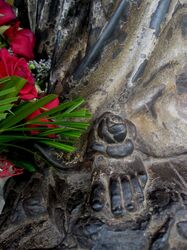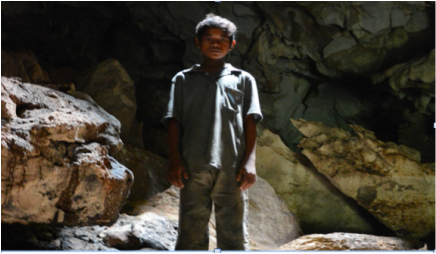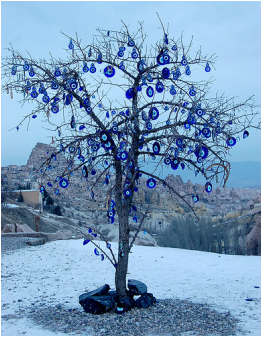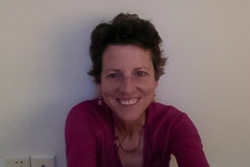Research The larger study considers interventions through apparition, dreams, statues, or amulets in four displaced communities. It is not intended to be a comprehensive ethnography. Rather, I consider that since the conflicts in religious lifeworlds occupy multiple realms, peacemaking must be approached with a wider and more creative arch of analysis.
In Cambodia, my project is called “Rescuing the ‘gods’: Dream knowledge and overlapping ontologies”. I study four cases where spirits appear in dreams to ask humans to rescue their Buddhist, Hindu and Catholic statues from a river, cave, and rice field.
Dream epiphanies led to the recovery of two Roman Catholic statues from the Mekong River in Cambodia. The first is of St. Francis who appeared in a dream and was then, as a statue, rescued by a Khmer man during the Khmer Rouge years. Most Khmer are hostile towards Vietnamese settlers; Roman Catholic Vietnamese are a particularly isolated community in Cambodia. Does this rescue a link the two differing faith ethnic communities as the Vietnamese Catholics suggest? Current relationships between Vietnamese Catholic and Khmer Buddhist communities at Wat Champa are strained. This is evident in different interpretations of the guardian statue that we continue to investigate. With the help of Vicith Keo, I interviewed Khmer leaders in the Wat Champa community adjoining the Vietnamese village and will continue in 2014.
Almost thirty years after the Khmer Rouge era, a statue of Mary was fished out of the Mekong River at Areykasat, a Vietnamese fishing town across the converging rivers from Phnom Penh. This statue, Our Lady of Lourdes, was found during Khmer New Year in 2008.
Four years later during the 2012 ASEAN meeting in Phnom Penh, a another statue of Mary was recovered, this time with the infant Jesus. In this case, a Buddhist Vietnamese fisherman in Areykasat was instructed in a dream to fish out a statue. Both statues are greatly venerated and draw weekly busloads of pilgrims from Vietnam.
In 2013, I interviewed key Catholic priests associated with both Wat Champa and Areykasat, attended the large celebration Mass of the first Mary on Cambodian New Year, April 16, returning several times after this.
My preliminary research project shifted dramatically to include two dream recoveries of Khmer statues. My colleague in this research is Mr. Samnang Seng, a well known peace activist in Cambodia who has designed and directed interfaith projects.
The two Khmer incidents of dream-inspired rescues occurred within a month of each other, the first on Cambodian New Year in Stung Treng, close to the Lao border. Stung Treng was originally part of two Lao kingdoms before the French ceded it to Cambodia. A 14 year-old poor settler dreamed that two monks guided him to a nearby cave to rescue statues. He found seventy-one small Buddhas high on a ledge in the cave’s interior. Though he had strict orders from his dream visitors to “take the statues to the royal palace,” the statues languish in the Stung Treng Provincial museum.
Fourteen days later on tngai sel, Buddhist new moon day, a rice farmer was told in a dream to “take them out”. He went to his rice field in Banteay Meanchay, the far west of Cambodia and discovered two 12th century Bayon-era Hanuman statues with their pedestals. The dreamer and his wife were escorted to Phnom Penh by Venerable Monyreth, a high-ranking monk to deliver the statues to the Deputy Prime Minister. Since then, the family has been deeply embedded in the Hanuman myth, particularly Mr. Lim’s son and sister-in-law, who have themselves become conduits for transmitting Hanuman’s wishes to the Cambodian people.
Mr. Seng and I visited Stung Treng and Banteay Meanchay several times since the initial meetings in May and July. Mr. Seng has returned to both sites to meet with family and government officials. In November, we met with other key figures in the Hanuman story in Phnom Penh and Banteay Meanchay. The stories continue to unfold. We are consulting with Dr. Greene whose knowledge of Khmer cosmology, its relationship to kinship and the body exceeds my own. As a scholar of Cambodia in residence, she writes, “I can assert with confidence that Dr. Poethig is pushing the boundaries of a breakthrough field of theory that is already troubling the status quo in the study of “religion” across disciplines.”
These five incidents of statue-rescue share several attributes. They occurred through dreams on auspicious days. The dreamer was not a religious specialist but a poor member of a marginal community. The dream recovery affected the dreamer, their family and community, affixing them to the mythic narrative of a statue rescue. That these statues are Catholic, Buddhist and Hindu, and the dreamers Khmer and Vietnamese offers an intriguing oneiric ecumene (cf Hannerz 1989) of cosmological détente. This oneiric ecumene recognizes that humans and spirits are both necessary for rescue of the statue. But it also contributes to a cosmopolitics of constructive trespass in which gods themselves violate cosmological allegiances, and humans are instructed to cross social and political divides. One wonders, what do the gods really want?




 RSS Feed
RSS Feed
